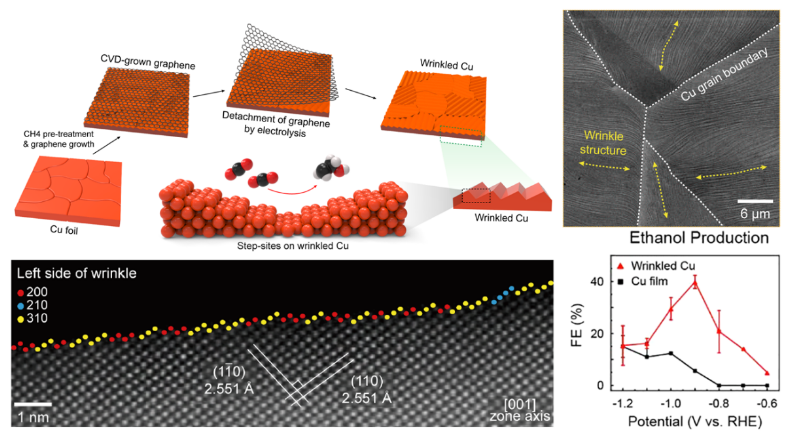As a research project for the Saudi Aramco – KAIST CO2 management center, Professor Hee-Tae Jung’s group developed a new film-type nanostructured Copper (Cu) with a periodic sharp wrinkle morphology for a CO2 reduction catalyst. The electrochemical reduction of CO2 represents a potential solution to the global climate change issue by enabling the conversion of CO2 into valuable products. Although several single-crystal based studies and simulation results have reported that areas rich in steps on Cu (100) surfaces are favorable for conversions toward C2 alcohol products, most studies continue to focus on low-index (100) facets or surface defect- derived low density levels of step- sites.
Professor Hee-Tae Jung and his research team realized high step-site density using Cu film with a high facet, atomic arrangement. A Wrinkle-shaped Cu catalyst with a high step-site density was achieved via the conventional chemical vapor deposition (CVD) graphene growth synthesis, which is both mass-producible and practical. CVD is well -known to enable graphene growth on a Cu surface. Methane (CH4) molecules dissociate at high temperatures and are adsorbed onto the flat Cu film surface; high-qualify graphene is obtained after the segregation and precipitation of carbon sources onto the Cu film. In terms of the Cu structure and morphology, after the graphene layer forms on the Cu film by the nucleation of a carbon source generated from methane, the thermal expansion energy difference between Cu and graphene results in both expansion and compression of the Cu top surface during the cooling process. This leads to the formation of a periodic hill-and-valley wrinkle morphology.
Ethanol was produced as a main product for CO2 conversion using a graphene-grown Cu film with a unique atomic arrangement. The wrinkle morphology strongly affects the ethanol formation by reaching 40% faradaic efficiency (FE) at -0.9 V vs a reversible hydrogen electrode (RHE), whereas the electropolished Cu catalyst showed 6% FE for ethanol production at the same overpotential. This FE is one of the highest values reported thus far for copper-catalyzed CO2 conversion to ethanol. Based on density functional theory (DFT) calculations, highly dense step-sites composed of numerous high-facet atomic arrangements lead to a favorable reaction energy barrier toward ethanol. The results of this research are expected to motivate researchers to fabricate various CO2 catalysts with controlled atomic arrangements on large-area films by the CVD graphene growth method and to open high reaction paths toward ethanol products through the manipulation of atomic arrangements. This study was published on April 23 in ACS catalysis (High facets on nanowrinkled Cu via chemical vapor deposition graphene growth for efficient CO2 reduction into ethanol., ACS Catal., 2021, 11, 5658-5665)

Prof. Hee-Tae Jung Department of Chemical & Biomolecular Engineering
Homepage: http://ooem.kaist.ac.kr
E-mail: heeate@kaist.ac.kr






